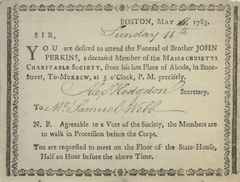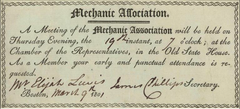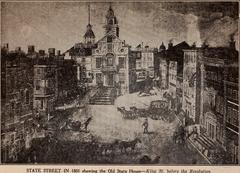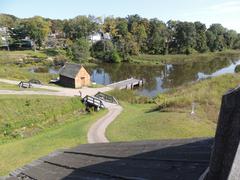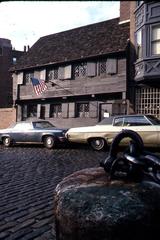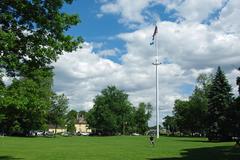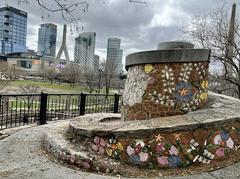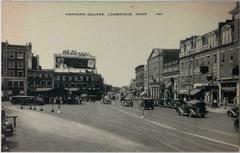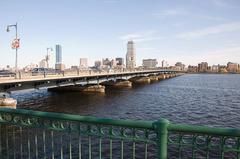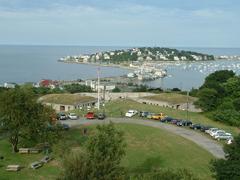
Visiting Hours, Tickets, and Historical Significance of the Old State House in Boston
Date: 19/07/2024
Introduction
The Old State House, located at the bustling intersection of Washington and State Streets in Boston, Massachusetts, stands as one of the oldest and most historically significant public buildings in the United States. Constructed in 1713, this iconic structure has witnessed some of the most pivotal events in early American history, including the Boston Massacre and the first public reading of the Declaration of Independence on July 18, 1776. The architectural beauty of the Old State House, with its Georgian style, grand staircase, and wood-paneled rooms, reflects the colonial aspirations of early American settlers (Historic New England). Over the centuries, it has served various roles, from the seat of the Massachusetts General Court to a city hall and now a museum dedicated to preserving its rich history (Bostonian Society). This guide aims to provide a comprehensive overview of everything you need to know for a visit, including historical context, visitor information, and practical tips to enhance your experience.
Table of Contents
History of the Old State House
Colonial Beginnings
The Old State House, constructed in 1713, originally served as the seat of the Massachusetts General Court. The building’s architecture is a fine example of Georgian style, characterized by its symmetry and classic proportions. It was built to replace the original wooden Town House, which was destroyed by fire in 1711 (Boston History).
Role in the American Revolution
The Old State House played a pivotal role in the events leading up to the American Revolution. It was from the balcony of this building that the Declaration of Independence was first read to the citizens of Boston on July 18, 1776. The building was a hub of revolutionary activity, hosting debates and meetings that shaped the future of the nation. Notably, it was the site of the infamous Boston Massacre on March 5, 1770, where British soldiers killed five colonists, an event that fueled anti-British sentiments (Massachusetts Historical Society).
Post-Revolutionary Era
After the American Revolution, the Old State House continued to serve as a government building. It housed the Massachusetts State Legislature until 1798, when the new Massachusetts State House was completed. Subsequently, the building was used for various purposes, including as a city hall, a commercial space, and even a museum. In the 19th century, the building underwent several renovations to preserve its historical significance (National Park Service).
Preservation Efforts
The Old State House faced numerous threats of demolition throughout its history, particularly during the urban development booms of the 19th and early 20th centuries. However, preservationists recognized its historical value and worked tirelessly to save it. In 1881, the Bostonian Society was formed with the primary goal of preserving the Old State House. The building was restored to its colonial appearance and opened to the public as a museum in 1882 (Bostonian Society).
Architectural Significance
The Old State House is an architectural gem, showcasing the Georgian style that was prevalent in the early 18th century. The building features a brick facade, large windows, and a distinctive cupola. The interior includes a grand staircase, wood-paneled rooms, and period furnishings that transport visitors back to colonial times. The building’s design reflects the aspirations of the early American colonies to emulate the grandeur of European architecture (Historic New England).
Visitor Information
Opening Hours and Ticket Prices
The Old State House is open to visitors from 9:00 AM to 5:00 PM daily. Tickets are priced at $12 for adults, $10 for seniors, and $6 for children aged 6-18. Admission is free for children under 6. Tickets can be purchased online or at the entrance.
Accessibility
The building is accessible to visitors with disabilities, with ramps and elevators available for ease of access.
Nearby Attractions
The Old State House is a key stop on the Freedom Trail, a 2.5-mile-long path through downtown Boston that passes by 16 locations significant to the history of the United States. Nearby attractions include Faneuil Hall, Boston Common, and the Paul Revere House (Freedom Trail Foundation).
Travel Tips
- Best Time to Visit: Mornings are generally less crowded.
- Getting There: The Old State House is easily accessible via public transportation. The closest T station is State Street on the Orange and Blue Lines.
- Parking: Limited parking is available nearby, so public transportation is recommended.
FAQ
What are the opening hours of the Old State House?
The Old State House is open from 9:00 AM to 5:00 PM daily. For the most current hours and any special closures, check the Bostonian Society website.
How much are tickets to the Old State House?
Tickets are priced at $12 for adults, $10 for seniors, and $6 for children aged 6-18. Admission is free for children under 6. Detailed pricing can be found on the Old State House ticket page.
Is the Old State House accessible to visitors with disabilities?
Yes, the building is equipped with an elevator, ramps, and accessible restrooms. It is recommended to contact the museum in advance to arrange any specific accommodations (accessibility information).
Are there guided tours available?
Yes, the Old State House offers a variety of guided tours and educational programs. Check the tour schedule for times and availability.
Conclusion
The Old State House in Boston is more than just a historical building; it is a symbol of the American struggle for independence and a testament to the enduring legacy of the nation’s colonial past. Its preservation and continued use as a museum ensure that future generations can appreciate and learn from this iconic landmark. Whether you’re a history buff, an architecture enthusiast, or a curious traveler, a visit to the Old State House offers a unique and enriching experience. Plan your visit, explore the nearby attractions, and immerse yourself in the rich historical tapestry that this iconic landmark has to offer. For more detailed information and updates, consider following the Bostonian Society and related historical organizations.
